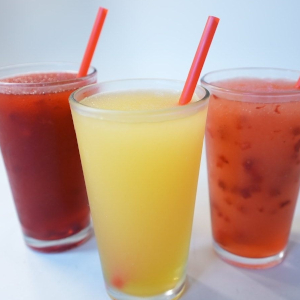I’ve written about this and related topics before, but the time has come for an update on, and review of the situation. First of all, I just don’t know why we need them in the first place. Second, I see increased danger in mixing them up with non-alcohlic beverages in the fridge, especially where there are kids around…
*
UPDATE: This Sunday Musings column appears a day late due to unexpected illness in the family yesterday – a first for the Fab Food Blog. Our apologies. Please consider one of the ‘Bonus’ posts we blast out several times a year as compensation. We’ll see you back here as usual, bright and early tomorrow!
*
 SONIC’s new spiked Seltzers: Leaning heavily on the SONIC brand name. At the same
SONIC’s new spiked Seltzers: Leaning heavily on the SONIC brand name. At the same
time, new ‘soft’ Slushes lean on booze-inspired names, flavours. The time is right
for some serious, potentially dangerous misapprehensions among consumers…
Some definitions and differentiations…
What we’re talking about today can include any otherwise-innocuous beverage that’s has intoxicants added. Adjectives used to refer to such drinks include: ‘spiked’ and ‘hard’ and We often hear of spiked or hard Cider or Tea. Lately, we’ve been hearing about spiked seltzer.
I have found this: ‘Spiked’ in today’s context can be ‘translated’ as ‘fortified’ or ‘alcoholized’. ‘Hard’ is the opposite of ‘soft’, as in ‘soft drink’ (or soda’, as some our readers say). ‘Spiked’ may also mean ‘adulterated’ or ‘contaminated’, if referring to certain circumstances, i.e.- ‘He spiked the punch with a mickey of Vodka when nobody was looking’. That adds the notion of sneakiness or stealth to the original meaning. But that’s not really an issue that falls under today’s context.
‘Laced’ can also be taken as a synonym for ‘spiked’ in today’s context.
First…
Why do we need some manufacturer to create and produce ‘spiked’ or ‘hard’ beverages when it’s so easy to make them ourselves – if we so desire? I expect it’s also cheaper, but I haven’t put too much research into that question. My time is too precious since I became a full-time caregiver to my 96-year-old Mom.
The quick answer is, “We don’t!” But somebody in the booze business glommed onto the fact, a few years back, that people were spiking innocuous beverages for recreational purposes, or to make them go down easier. And the new category of alcoholic beverages called ‘coolers’ was born. From there, we’ve gone on to pre-mixed hard drinks, and concoctions such as Sangria and Margaritas have been added. The underlying idea is to offer your average modern drinker a broader range of choices, over a wider range of alcohol strengths, all with the same ultimate degree of convenience, i.e.- ‘as easy as opening a beer’.
There’s nothing wrong with that, providing the drinker doesn’t mind paying a mark-up for the extra preparation effort.
Second…
But there is a side of the new trend that poses some questions that need to be answered. For example: what if a kid mistakes a ‘spiked’ version of a fizzy beverage for the harmless kind? We’ve not heard of any specific figures about such incidents, but we have heard from public heath officials about a parallel one – how kids and adults have suffered overdoses of THC (the active ingredient in Marijuana-spiked foods and beverages) because the responsible adults in the situation failed to label the products properly. I suspect there are as many or more alcohol-related incidents over any given period of time.
I also suspect that many folks underplay the danger of the alcohol-based incidents because beverage alcohol has long been seen as an ‘acceptable’ social sin, not an unhealthy, dangerous substance. Familiarity breeds carelessness.
Labeling an issue
A major issue that goes hand in hand with the ones enumerated above is that kids of certain younger ages can’t read or don’t understand the warning symbols or keywords on the labels of some potentially dangerous products. These would include ‘alcohol’, ‘spiked’ and ‘hard’. Yet adults leave such products in shared, family refrigerators where kids can easily get to them.
There’s also the issue of cannabis products which may not be labeled as such because they’ve been made at home (often in jurisdictions where cannabis not strictly legal, yet). We’re continually hearing about kids and adults who get into overdose trouble with weed edibles because they’re not labeled. Folks assume that they’re not ‘spiked with anything, and eat way too many. The majority of cannabis-laced edibles fall into the baked goods and candy categories – which look all too familiar – and enticing – to kids and won’t taste any different than plain, unenhanced ones.
My biggest concern…
… Is that kids of all ages will make even more mistakes misreading the labels of the new ‘spiked seltzer’ products which are proliferating wildly this early spring, and certain to be just about everywhere this summer.
I was especially alarmed by the twin announcements by SONIC, the drive-in burger joint, which is getting ready start selling spiked beverages under its familiar label – beverages trading on the names if its already familiar non-alcohol fountain beverages. And if that wasn’t bad enough, they’re also preparing a line of ‘soft’ drinks whose names blur the lines by mimicking, in greater or lesser terms, those of alcoholic beverages or mixed drinks (with flavours such as Peach Bellini, Red Berry Sangria, and Strawberry Frosé). We certainly don’t need another added dimension of potential confusion!
I think it’s time to start taking a long, serious look at the labeling of ‘spiked’ beverages with the goal of standardising the practice and erring on the side of ‘excess caution’ in the case pf products that are potentially extremely dangerous. And it’s time that the manufacturers took full responsibility for the safety of the products they sell.
~ Maggie J.

